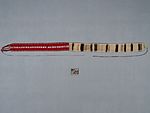Belt
About this object
History of use
The techniques, structures and some of the motifs have pre-Conquest antecedents. This type of textile conveys the most about an individual's ethnicity, sex, age, status and particular history. Belts of this width are worn by teenage girls. The stiff underbelt supports the back when doing physical labour. It also displays the belt flatly to best advantage for special occasions like church or fiestas. Adult men and women wear wider red belts and underbelts. New belts are woven for specific calendar and life events. Afterwards they are reserved for special occasions until they begin to show wear and are relegated to everyday wear. Males weave the underbelt on a fixed frame loom.
Narrative
The red belt was woven by Elena Quispe Flores, 19 years old, for her own use and the underbelt was woven by her adoptive father, Ascencio Huatta Yucra. Elena had only worn it 3 or 4 times for going to church. The underbelt is about 10 years old, while the red belt is quite new.
Iconographic meaning
The range of motifs refers to local geography and landmarks, ecology, fecundity, as well as luck. The six part circle refers to the division of land into six sections on Taquile, and the rotation of crops and fallow periods. Starting with the braided end of the belt, a bird is shown eating the crops grown in the six sectors; two birds eating barley; a marriage altar; a bird; a road with three sectors and a bird; altar for the 24th of June fiesta; a chicken who eats corn plants; a cow; a black bird (alcamari) which signals good luck; a house; evening star (chisin paya); and an s-shape which refers to the crops in other sectors of the Island. In the narrow design panels, a large diamond, with four small diamonds within, is called 'vaca wisa' or pregnant cow. An angular 's' shape is called 'raukana', a hooked hand tool for cultivating the land. The colour stripes in the centre and flanking the design panels have particular associations: green is associated with plants, pink with flowers, blue with water, and orange with danger (too much rain, for example).
Specific techniques
Patterned belt: commercial synthetic yarns, z spun and plied 2-s, are retwisted on the drop spindle before warping. The plain stripes are warp-faced plain weave, the central pattern band is double cloth (also warp-faced plain weave) and the side pattern bands and narrow ties are complementary warp weave with three span floats aligned in alternate pairs. Groups of warps at one end are braided in three strand oblique interlacing. The belt is woven to size on a continuous warp and the terminal area is braided; stitched to a separately woven underbelt. Underbelt: warps of women's hair are spun s and plied z. The sheep's wool wefts are z spun and s plied. The woven structure is weft wrapping. Underbelt is woven to size on a continuous warp and has four selvedges; stitched to the red belt and narrow tie. The belt, underbelt and two ties are woven on separate warps and assembled by sewing and knotting.
Physical description
Belt with three bands of geometric and figurative motifs in off-white, dark red and green on a red ground. Motifs of birds, a cow, a house and geometric figures decorate the central band. Sewn at one end to a stiff thick belt irregularly cross-striped in light and dark shades of natural wool. The opposite end of the red belt is finished with 18 braids which are grouped together by a cord knotted to a very narrow woven tie with geometric patterns. A similar cord and tie is attached to the non-sewn end of the stiff belt section.
Categories
Materials
